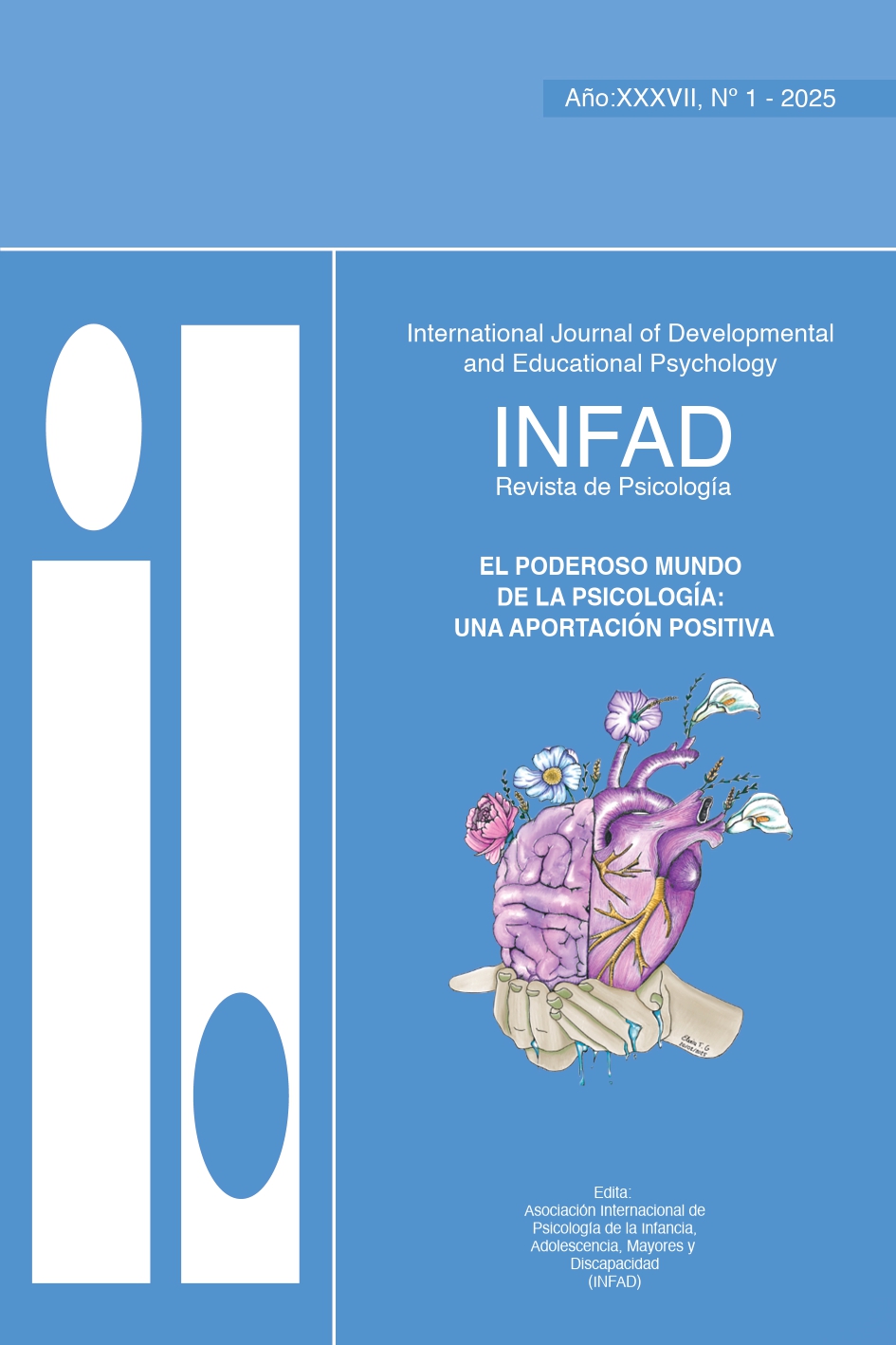Anxiety, depression and stress as explanatory factors of problematic use of social networks in high school students
Main Article Content
Abstract
The aim of this study was to examine the relationship between problematic social media use and levels of anxiety, depression, and stress among adolescent students. The Depression, Anxiety and Stress Scale-21 (DASS-21) and the Problematic Use of Social Media Questionnaire were administered to a sample of 1,164 students from Compulsory Secondary Education and the first year of Baccalaureate programs (M = 14.56; SD = 1.40). The data revealed positive and statistically significant correlations between problematic social media use and the variables of anxiety, depression, and stress. Furthermore, students classified as having high levels of problematic social media use reported significantly higher mean scores in anxiety, depression, and stress compared to those with moderate or low use. Additionally, the likelihood of exhibiting high problematic use increased by 1.18, 1.26, and 1.25 times for each one-unit increase in anxiety, depression, and stress, respectively. These findings underscore the need for preventive and intervention strategies targeting emotional difficulties among adolescents with problematic social media use.
Article Details
Section

This work is licensed under a Creative Commons Attribution-NonCommercial-NoDerivatives 4.0 International License.
Attribution — You must give appropriate credit, provide a link to the license, and indicate if changes were made. You may do so in any reasonable manner, but not in any way that suggests the licensor endorses you or your use.
NonCommercial — You may not use the material for commercial purposes.
NoDerivatives — If you remix, transform, or build upon the material, you may not distribute the modified material.

This work is licensed under a Creative Commons Attribution-NonCommercial-NoDerivatives 4.0 International License
How to Cite
References
Adams, M. (2016). Internet addiction: Prevalence, risk factors and health effects . Nova.
Ahmed, O., Walsh, E. I., Dawel, A., Alateeq, K., Espinoza Oyarce, D. A., y Cherbuin, N. (2024). Social media use, mental health and sleep: A systematic review with meta-analyses. Journal of Affective Disorders , 367, 701–712. https://doi.org/10.1016/j.jad.2024.08.193
Bados, A., Solanas, A., y Andrés, R. (2005). Psychometric properties of the Spanish version of Depression, Anxiety, and Stress Scales (DASS). Psicothema, 17 (4), 679-683.
Casale, S. (2020). Problematic social media use: Conceptualization, assessment and trends in scientific literature. Addictive Behaviors Reports, 12 . https://doi.org/10.1016/j.abrep.2020.100281
Cohen, J. (1988). Statistical power analysis for the behavioral sciences (2ªEdición.) Hillsdale, NJ: Erlbaum.
Course-Choi, J., y Hammond, L. (2021). Social media use and adolescent well-being: A narrative review of longitudinal studies. Cyberpsychology, Behavior, and Social Networking, 24 (4), 223-236. https://doi.org/10.1089/cyber.2020.0020
Delgado, B. y Martínez-Monteagudo, M.C. (2023). Cuestionario sobre el uso problemático de las redes sociales en adolescentes. Disertación no publicada. Universidad de Alicante.
Echeburúa, E., y Corral, P. (2010). Addiction to new technologies and to online social networking in young people: A new challenge. Adicciones, 22 , 91-96.
Echeburúa, E., Labrador, F. J., y Becoñá, E. (2017). Adicción a las nuevas tecnologías en adolescentes y jóvenes. Pirámide.
Echeburúa, E., y Requesens, A. (2012). Adicción a las redes sociales y nuevas tecnologías en niños y adolescentes . Pirámide.
Fassi, L., Ferguson, A. M., Przybylski, A. K., Ford, T. J., Orben, A. (2025). Social media use in adolescents with and without mental health conditions. Nature Human Behavior . https://doi.org/10.1038/s41562-025-02134-4
Hussain, Z. y Griffiths, M. D. (2018). Problematic social networking site use and comorbid psychiatric disorders: A systematic review of recent large-scale studies. Frontiers in Psychiatry, 9 , 686. https://doi.org/10.3389/fpsyt.2018.00686
Ivie, E. J., Pettitt, A., Moses, L. J., y Allen, N. B. (2020). A meta-analysis of the association between adolescent social media use and depressive symptoms. Journal of Affective Disorders, 275 , 165–174. https://doi.org/10.1016/j.jad.2020.06.014
Lopes, L. S., Valentini, J. P., Monteiro, T. H., Costacurta, M. C. F., Soares, L. O. N., Telfar-Barnard, L., y Nunes, P. V. (2022). Problematic social media use and its relationship with depression or anxiety: A systematic review. Cyberpsychology, Behavior and Social Networking, 25 (11), 691–702. https://doi.org/10.1089/cyber.2021.0300
Lovibond, S., y Lovibond, P. (1995). Manual for the depression anxiety stress scales . Psychology Foundation.
Malo, S., Martín-Perpiñá, M. M., y Viñas, F. (2018). Excessive use of social networks: Psychosocial profile of Spanish adolescents. Comunicar , 56 , 101-110. https://doi.org//10.3916/C56-2018-10
Meshi, D., y Ellithorpe, M. E. (2021). Problematic social media use and social support received in real-life versus on social media: Associations with depression, anxiety and social isolation. Addictive Behaviors, 119, 106949. https://doi.org/10.1016/j.addbeh.2021.106949
Moretta, T., Buodo, G., Demetrovics, Z., y Potenza, M. N. (2022). Tracing 20 years of research on problematic use of the internet and social media: Theoretical models, assessment tools, and an agenda for future work. Comprehensive Psychiatry, 112. https://doi.org/10.1016/j.comppsych.2021.152286
Sarmiento, I. G., Olson, C., Yeo, G. H., Chen, Y. A., Toma, C. L., Brown, B. B., . . . Mares, M. (2020). How does social media use relate to adolescents’ internalizing symptoms? conclusions from a systematic narrative review. Adolescent Research Review, 5 (4), 381-404. https://doi.org/10.1007/s40894-018-0095-2
Schivinski, B., Brzozowska-Wo , M., Stansbury, E., Satel, J., Montag, C., y Pontes, H. M. (2020). Exploring the role of social media use motives, psychological well-being, self-esteem, and affect in problematic social media use. Frontiers in Psychology, 11 . https://doi.org/10.3389/fpsyg.2020.617140
Shannon, H., Bush, K., Villeneuve, P. J, Hellemans, K. G, Guimond, S. (2022). Problematic social media use in adolescents and young adults: Systematic review and meta-analysis. JMIR Mental Health, 9 (4):e33450.
Tandon, A., Dhir, A., Almugren, I., AlNemer, G. N., y Mäntymäki, M. (2021). Fear of missing out (FoMO) among social media users: A systematic literature review, synthesis and framework for future research. Internet Research, 31 (3), 782-821. https://doi.org/10.1108/INTR-11-2019-0455
Zsido, A. N., Arato, N., Lang, A., Labadi, B., Stecina, D., y Bandi, S. A. (2021). The role of maladaptive cognitive emotion regulation strategies and social anxiety in problematic smartphone and social media use. Personality and Individual Differences, 173 . https://doi.org/10.1016/j.paid.2021.110647

